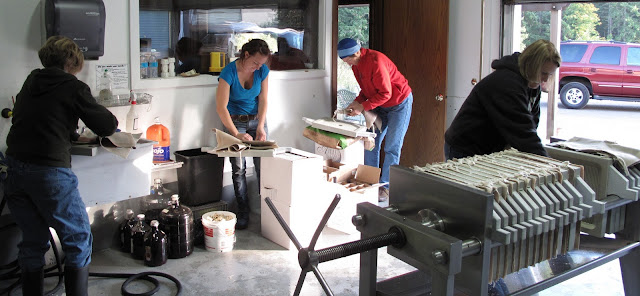 Hello All,
Hello All,Sorry it has been so long but the last
The last fruit came in on November 2nd, so a quick harvest as far as picking goes. I was hoping we would still get in the Riesling from both our vineyard and BeckenRidge but no luck. The cold temperatures at the start of November were both a help and a hindrance. While on the positive side the Pinot noir was able to get a longer cold soak than normal and the Rose had plenty of time to develop color, the cold temperatures made it difficult to get fermentations to start in the whites and later in the pinot noirs. It also was a factor in why we were unable to bring in the Riesling, it just stopped ripening in those low temperatures even with the green leaves.
After we finally got everything going it has been chugging along quite nicely and in the last week stopped the fermentations on the Muller Thurgau and the Viognier. The first tank of Pinot gris went dry and I have my fingers crossed for the other two as well as the Gewurztraminer. The Riesling we bought from southern Oregon is perking along nicely and I figure I'll be stopping that in the next week. The Chardonnay and Pinot noir Rose is barrel have been going a little slower but they should be dry in the next two weeks and then I can start messing with the 7 blend.
 As for the reds they fermented quite quickly after we got them warmed up and have been pressed off and racked to barrel. I am quite happy with what we have there and am anxious to taste them after they go through malolactic fermentation (ML). ML should also help with the acidity and bring some roundness to the mouthfeel. I'll probably have to start warming the barrel room in order to help the ML to go through after I inoculate next week but I'll make that decision when I get there.
As for the reds they fermented quite quickly after we got them warmed up and have been pressed off and racked to barrel. I am quite happy with what we have there and am anxious to taste them after they go through malolactic fermentation (ML). ML should also help with the acidity and bring some roundness to the mouthfeel. I'll probably have to start warming the barrel room in order to help the ML to go through after I inoculate next week but I'll make that decision when I get there.I hope you enjoy the pictures, they don't really tell a story I just tried to snap some whenever I had the chance. If something really interested let me know and I'll explain further. Next week I hope to post the life pictures of our two clusters.
I hope you all had a great Thanksgiving and that you enjoy the up coming holidays.
Cheers, Elizabeth














